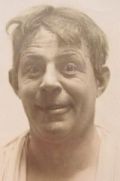Vaudeville and revusical character, aka Stiffy the Rabbitoh.
Nat Phillips's alter-ego Stiffy first appeared on stage in 1914 in a series of sketches performed with his wife, Daisy Merritt, and in occasional farces presented by the troupes he also directed (see note below). The character is believed to have been the first on the popular culture stage to clearly express and be identified with Australian attitudes and idioms. According to Phillips, his idea was to create a larrikin character from the inner-city heartland of Waterloo and Redfern, someone who not only spoke the same way as the audiences he appeared in front of, but whose mannerisms, thoughts, and expressions were both relevant to and reflective of that audience (Theatre January 1919, p.4).
That Stiffy's widespread appeal came about at a time when Australia had only recently begun to consider itself as a distinct and separate nation is not surprising. Australia's early involvement in the First World War played a significant role in providing a groundswell of interest around Australia for local characters being depicted on the stage. Stiffy's popularity with audiences from his first introduction in late 1914 indicates that there was a desire by the popular culture audience, at least, to see fully rounded, immediately identifiable local characters on the stage, telling stories or acting in situations that had social and cultural relevance to their everyday lives.
By mid-1915, Stiffy's popularity with audiences was such that Phillips was forced to write to Australian Variety (shortly after leaving Australia for a tour of the East), warning other practitioners that he held 'the Australian rights to the "Stiffy" series of sketches recently worked by him over the Fuller circuit... [and that it was his] intention to proceed against any performers infringing on them' (13 October 1915, p.12). Over a period of some eighteen months to two years, Phillips refined and developed Stiffy's traits so that by mid-1916, he had become something more than caricature or a two-dimensional stage character. As Phillips himself notes in 1919, at the height of Stiffy and Mo's popularity:
Until I brought Stiffy on the scene the Australian low-life character - the larrikin - was always portrayed as a [London] coster. This always appeared incongruous to me. It came about as the result of imported comic songs and comedy routines. I decided to try the experiment with the Sydney larrikin. Steele Rudd made Dave and Australian bush type. I determined to come nearer home and present a city type. I couldn't have wished for greater success along the line I followed' (Theatre January 1919, p.4).
Among the farces and sketches featuring Stiffy identified during the years 1914 to mid-1916 were 'The German Invasion, 'The S. S. Maysail [aka Stiffy the Steward'), 'The New Butler,' 'The Squaw,' 'On the Road' and 'Stiffy the Lunatic.'
The pairing of Phillips and Roy Rene as Stiffy and Mo in July 1916 occurred after Phillips was recalled to Sydney from Brisbane by the Fullers. Asked to take control of a revusical troupe previously run by Albert Bletsoe, he brought in several highly experienced Fullers performers to complement those remaining from the original company. Rene, one of the Bletsoe performers, was given the opportunity to appear as Stiffy's offsider, Mo.
What made the Stiffy and Mo partnership different to other comedy duos, including the Phillips and Merritt team, was their disregard for the traditional straightman/comic relationship. Instead they played off each other for laughs. This egalitarian approach established a strong bond with audiences who saw Stiffy and Mo as the embodiment of Australian mateship. This ideological perspective, until then overlooked by variety performers and writers, helped turn Stiffy and Mo into not only stars but also Australian social and cultural icons. Phillips and Rene played Stiffy and Mo in revusicals and in the Fullers' pantomime spectaculars in both Australia and New Zealand through until December 1928, albeit with an eighteen months break beginning mid-1925.
During Stiffy and Mo's eighteen-month separation, Phillips toured his Whirligigs company and teamed up with Jack Kellaway as Stiffy and 'Erb. When Rene reunited with Phillips during the final four weeks of the Whirligig's Brisbane season (February 1927), the shows featured the trio Stiffy, Mo, and 'Erb. The following month, Stiffy and Mo opened in Sydney (Fullers' Theatre), going on to establish a house record at that theatre.
The iconic partnership went on to play seasons in Melbourne and Adelaide, followed by a tour of New Zealand. Shortly after returning to Australia the two comedians ended their partnership for ther final time. Phillips continued to present Stiffy on stage with his Whirligigs company up until his death in 1932.


